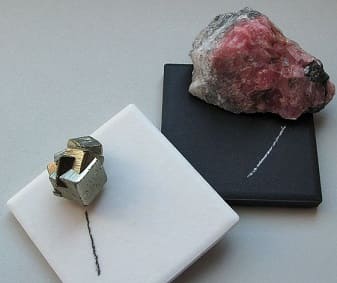Optical properties of minerals
They are the properties that occur when light on a mineral.
Some of the optical properties of minerals are:
- The luster.
- The transparency.
- The color.
- The stripe.
- The luminescence.
- The birefringence.
They are the properties that occur when light on a mineral.
Some of the optical properties of minerals are:
The brightness is the physical property that describes the aspect of the surface of mineral when when light is reflected on it. The brightness of a mineral is totally independent of the color of said mineral.
For example, the brightness of a mineral can be:
The transparency is the property that some minerals to let light pass through them.
Minerals, as they allow the passage of light, can be classified as:
Although at first glance, most of the minerals appear opaque, if a microscopic cut is made it can be seen that they are translucent minerals. This allows the use of the microscope to be one of the most reliable ways to identify minerals, since their recognition of visu is very complicated.
The color of a mineral depends on the light that the mineral reflects. It is one of the most striking and easy to observe characteristics, and it can be decisive to identify a mineral such as azurite (blue), olivine (olive green), sulfur (yellow), malachite (green), ..., but you have to keep in mind that, in some cases, any impurity in the mineral can cause it to change its color. There are also minerals, such as fluorite, which can have different shades, such as blue, green, purple, pink, etc.
Therefore, although it is probably the first thing we look at when we see a mineral, we have to exercise some caution when using it to determine what mineral it is.
The streak of a mineral is the color that the mineral has when it is reduced to powder.
This property is useful to identify the mineral in situ if we have a white porcelain in which to make the line and be able to observe its color, since the color of the line is constant for each mineral, unlike the color that can vary from one exemplary to another.
It should be borne in mind that not always the color of the streak of a mineral is of the same color, the mineral. For example, pyrite is usually yellow in color, but its stripe is black.

By Ra'ike (see also: de:Benutzer:Ra'ike) [GFDL or CC BY-SA 3.0 ], from Wikimedia Commons
The luminescence is the property that some minerals emit light after absorbing some form of energy.
For example, some minerals, such as fluorite, emit light when illuminated with ultraviolet light.
When the luminescence ceases after the energy form has ended, we speak of fluorescence. On the other hand, if it remains after having finished that form of energy, it speaks of phosphorescence.
The birefringence or double refraction is an optical property of having some minerals, such as Iceland spar (a variety of calcite), consisting of unfolding an incident beam of light into two, forming a double image.
As a curiosity, it is worth highlighting the "television effect" of ulexite, in which the text below it is projected onto its surface, leaving the surface as a kind of television.
The optical properties of minerals have also been discussed in other courses:
Obra publicada con Licencia Creative Commons Reconocimiento Compartir igual 4.0